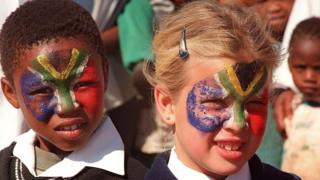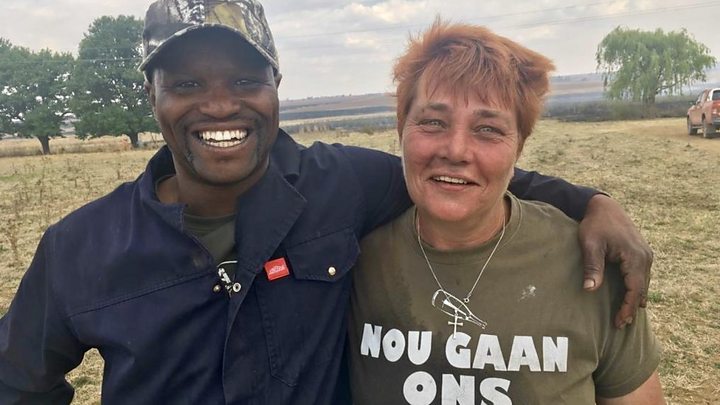How race relations in the ‘rainbow nation’ have become toxic
BBC Africa editor Fergal Keane visits South Africa’s conservative rural areas nearly 25 years after white-minority rule ended, and finds that racism is still deeply embedded but there are also symbols of racial reconciliation.
It was a young boy who noticed us and ran to tell his father. Around 10 years old, blond-haired and barefoot, he rushed indoors. The child looked scared. It was dusk and we were strangers.
I caught sight of him in the rear-view mirror as we drove along the dirt road that ran past the tall steel fence that encircled their home.
Maybe 10 minutes later, a car approached from behind. Headlights flashed, beckoning us to stop.
Revolver on hip
We pulled up within a few yards of each other. It was an old car, a Toyota from the 1990s. Beaten and rusted, it is a vehicle of the rural poor.
A young white man got out. He wore a baseball cap pulled down over his forehead and his right hand sat on the revolver strapped to his hip.
There was a young woman with a baby on her lap in the front seat. She looked exhausted, her hair lank and eyes struggling to stay open. The child was ill, coughing and its face covered in red blotches.
I saw the man relax as I got out of the car and approached him. I greeted him in Afrikaans. The hand came away from his hip.
“You frightened them, you know,” he said, pointing towards the house.
“They called up on the radio and we came to check on you. They didn’t know who you was. We talk to each other on the radio.”
He said there had been farm attacks in the area. There was constant theft.
The young man pointed across the railway tracks to where the fields were now dissolving into the dark.
“The farmer over there, if he sees anyone on his land, he is likely to just take a shot. He will fire at anything. Be more careful, man,” he said.
‘We will level them with the gravel’
This was near Potchefstroom on the “platteland” – an Afrikaans word which refers to the great rolling heartland encompassing vast swathes of the South African interior.
More than 20 years after watching black and white leaders negotiate an end to the racist system of apartheid, I was driving west of the main city, Johannesburg, to test how much had changed in what had been the most conservative part of South Africa.
Potchefstroom, Ventersdorp, Fochville and numerous other towns and villages had provided the muscle for an abortive right-wing rebellion.
The leader of the neo-Nazi Afrikaner Resistance Movement (AWB), Eugene Terreblanche, had sworn never to surrender to black rule.
“We will level them with the gravel,” I’d heard him declare one hot afternoon in Ventersdorp. There were threats to set up white republics.
But the rebellion failed, snuffed out when a black soldier killed three AWB members in cold blood on a rural road and terrified the rest into going home and living with the new dispensation.
This was after AWB members shot civilians in and around the platteland town of Mafeking in March 1994.
Resenting inequality
Terreblanche was murdered 16 years later by one of his own workers. His movement splintered, shrank and became irrelevant.
Most Afrikaners accepted the compromise which led to black majority rule.
But travelling across the platteland, it is obvious that while dreams of white secession have evaporated, there is much that is unchanged.
I was going back to a place where many black people resent the inequality which keeps 67% of arable farmland in white hands, and where white people fear violent attack and dispossession.
It is not that South Africa has become newly racist, unequal or violent. It was always all of these things.
The violence of racial discrimination and the resentment it bred are part of the nation’s DNA.
‘Beaten unconscious’
Social media has provided an outlet for amplifying the crudest racial slurs and anger over corruption and inequality have stoked an increasingly febrile environment.
What is striking is the way in which racial resentment can still be so brutally expressed.
Last February a 22-year-old black athlete, Thabang Mosiako, was walking with some friends in Potchefstroom when he saw a shop assistant being insulted by a group of young white men.
It was a Saturday night. When Mr Mosiako and a friend intervened, they were set upon.
“They were hitting me until I was unconscious,” he remembered. “Then I woke up in the hospital, not knowing what happened.”
His friend, also an athlete, suffered a broken arm. Mr Mosiako runs for South Africa and lost three months from his training because of the beating he received.
Worse, he says, is the lingering trauma and fear when he sees groups of white men.
“I feel really scared. I can’t even go to town alone. I don’t know when and where will they come back again.”
‘Alcohol thrown’
Travel 300km (186 miles) north-east to the town of Middelburg and you learn that racist violence can still be lethal. The town has some bad history.
In August 2016 two white farmers were filmed beating and then forcing a black man into a coffin in which they told him he would be buried alive. They were given sentences of 11 and 14 years.
In another case, Xolisile Ndongzana, 26, was driving home in Middleburg one night last July when he found the road blocked by a group of white men.
They approached the car and threw alcohol through the open window, drenching the occupants. Mr Ndongzana was dragged out. His friend, Laurence Nelumoni, witnessed the violence.
“They pulled out my friend and beat him. When I tried to save him, it was too late. They used all these ‘k-words’ – black, kaffir, everything. It was terrible.”
The “k-word” was the most offensive racial slur used to humiliate black people during the apartheid years. It is a symbol of de-humanisation.
Mr Ndongzana died of his injuries. The white attackers have yet to be charged.
Mr Nelumoni is rueful when I ask if those who witnessed the end of apartheid were wrong to believe in a “rainbow nation” – the multiracial patchwork of peaceful co-operating groups.
“You were wrong. It’s not a rainbow nation. Whites still have more powers.”
What was apartheid?
As so often in this country, and in this particular place, there are competing narratives of fear.
The white farmers of the platteland worry that their land will be seized under government proposals to take property without compensation.
Inflammatory words
Populist politicians in the radical Economic Freedom Fighters (EFF) and some local leaders of the governing African Nationalist Congress (ANC) have been accused of stoking racial tensions.
The South African Human Rights Commission is taking one radical black leader to court over comments he made calling for the killing of white people.
Andile Mngxitama, who leads the Black Land First organisation, represents a political fringe but his comments have received widespread publicity and heightened racial tensions.
The attacks on white farms – long a feature of rural life – have deepened a sense of alienation from the government on the part of some white farms.
Right-wing groups have spread the myth of a white genocide abroad. There is no genocide but there is genuine fear of physical attack and dispossession.
More on race relations:
Bernadette Hall witnessed the murder of her husband on their farm near Fochville in 2012.
Her land is parched and browned from a long southern winter without rain. The cattle are lean. We are standing outside the dairy building where Mrs Hall witnessed her husband’s death.
“They beat him and he fought with them. But by the end he was on his knees and the one black guy just shot him,” she said.
She was beaten and tied up as the attackers hunted for money and guns. They found neither.
Her two sons live in the nearby town and constantly urge their mother to move away from the farm. But she will not go.
“This is my land. I didn’t steal it. Why should I move? I belong here,” Mrs Hall said.
Capacity to surprise
Had I left at that moment, I would have come away with an impression of a world incapable of change. The angry racist outbursts and the constant discussion of race on social media give the country a claustrophobic feel these days.
But a recent opinion poll by the South African Institute of Race Relations think tank gives some cause for hope.
The telephone survey found that 77% of black respondents had never “personally experienced racism directed against them”.
The same percentage said that “with better education and more jobs, the differences between the races will disappear”.
Another survey by Afrobarometer found that 92% of South Africans expressed themselves as tolerant towards other ethnicities.
Then something happened on our platteland journey. It was at once surprising and yet strangely familiar, a testament to this country’s endless capacity to surprise.
Earlier we had spotted a bush fire sending a huge cloud of white smoke into the pale blue of the sky. It seemed to be growing in strength. There was a call to Mrs Hall’s phone. The man on the other end was speaking Afrikaans and talking about the fire.
“Come on. He needs help,” she said.
‘Great neighbours’
We headed in the direction of the smoke. Mrs Hall led the way in her “bakkie” – the ubiquitous pickup jeeps of the platteland – and in a few minutes we were in the middle of the fire and Mrs Hall was shaking the hands of a black man who was fighting the flames.
“This is Firi. He’s my neighbour,” she said.
Firi Lekhetha owned the land next to Mrs Hall. He was a young man who had emigrated to the UK to play professional rugby, earned some money and returned to try his hand at farming under a government scheme to encourage black farmers.
Soon other white people were arriving and local black farm workers too. The flames were advancing towards Mr Lekhetha’s home. Together the group fought them back. They knew the truth of the platteland fire. It spreads. It does not respect fences.
“These are great neighbours,” Mr Lekhetha shouted to me. “They are always here for me.”
The flames subsided. Exhausted people slumped on the ground or leaned against bakkies.
Mr Lekhetha and Mrs Hall shook hands. He thanked her for the help; she thanked him for the loan of some petrol. I began to ask about the problems of racial animosity on the platteland.
Mrs Hall interrupted: “What animosity do you see here? None. There’s none.”
It would be wrong to read too much into the dynamics of a single incident. As I saw earlier in the journey, racism remains pervasive and toxic in South Africa.
But the symbol of a fire that consumes all – irrespective of race – is a potent one for this country.
As much as they did in 1994, at a time of historic compromise, South Africans need each other.
Source: Read Full Article




